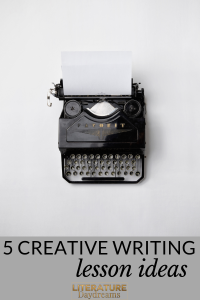5 creative writing lesson ideas you can use today!

If you are looking to liven up your creative writing teaching or your students need some fresh ideas to improve and develop their creative writing in class – then this blog post is for you!
Below are 5 of my favourite ways to mix things up a little when I am teaching creative writing!
- Slow writing
- People watch to write people
- Changes over time
- Opening lines
- Add meaning to your settings

Slow down writing
These writing prompts focus on s-l-o-w writing. Slow writing is the opposite of a quick write. The idea is to write slowly, precisely, carefully, selecting each word intentionally. Slow writing can take 5 minutes with one sentence and 30 minutes with a paragraph.
- Write this moment of action. Imagine it in slow-motion. Try and recreate this in your description.
Imagine your family is eating a meal together. Someone knocks over a drink and it spills across the table. Describe this moment. - It is sunset and you are waiting for your friends, who are late. This moment is slow. You are waiting. Probably bored. Perhaps a bit annoyed. Walk your reader through the tick, tick, tick of your watch as you wait. Describe the setting as the day moves towards darkness.
People watch to write people
- Sit somewhere public (the cafeteria at school is perfect for this).
- Describe the faces of 5 strangers, show personality through expressions and gestures.
- When you have your 5 descriptions, create some conflicts between them.
One character bumps into another character. One character asks another for help. - How would your character react based on the personality you created for them?
Changes over time
This writing task is all about describing the same setting at three different points during the day. You can use different settings, for example, I sometimes use the grounds at my school.
- Write a description of a summer funfair as the workers are setting up the rides and stalls.
- Write a description of the same funfair – this time in the mid-afternoon, just as the first crowds begin to arrive.
- Write a short narrative set at the same fun fair – now write the fair and attendees as evening falls.
I use these 3 prompts in different ways. Sometimes I do gradual writing with students and they write each one, in turn, changing – shaping – adapting their own funfair as the day passes.
Another way is to put your students into triad groups and have them write one each. They can then share and improve based on the best bits of each other’s writing.
Opening lines
I love to use open lines as a writing activity with my classes because it always amazes me where students will go with the same opening. You could give them one line and end up with 30 completely unconnected stories.
Below are the 3 opening lines that I found to create an excellent and diverse range of stories:
- I covered my eyes but nothing …
- I said orange…
- Bad, very bad…
Add meaning to your settings
I started teaching Khaled Hosseini’s A Thousand Splendid Suns this week and it is a joy, an absolute joy to get stuck into such a beautiful piece of writing.
Re-reading the opening, I am always reminded of how much our landscapes shape who we are. Let me transport you for a moment. If you don’t know the novel, a shunned woman and her illegitimate daughter are sent to live in a shack isolated in the countryside of Afghanistan.
Here is Hosseini’s description: It was on the outskirts of Gul Daman. To get to it, one took a rutted, uphill dirt track that branched off the main road between Herat and Gul Duman. The track was flanked on either side by knee-high grass and speckles of white and bright yellow flowers. The track snaked uphill and led to a flat field where poplars and cottonwoods soared and wild bushes grew in clusters.
I love how Hosseini highlights their isolation, the mother’s ‘off track’ actions, the ‘uphill’ life they lead, and a hundred other details in his description.
It would make a great mentor text example for a piece of descriptive writing. For example: create a description of the landscape of where you live, the nature rather than the buildings. BUT as you describe it, give the details in the landscape significance to show something about your own life experience.


Love Creative Writing in your classroom!
Are you ready for dynamite descriptive writing in your classroom?Download your FREE 3-step guide now!
*I send emails with teaching tips, tricks, and free resources to my subscribers regularly. I value your privacy and you can learn more about how I handle your data in our private policy. You can unsubscribe at any time.

